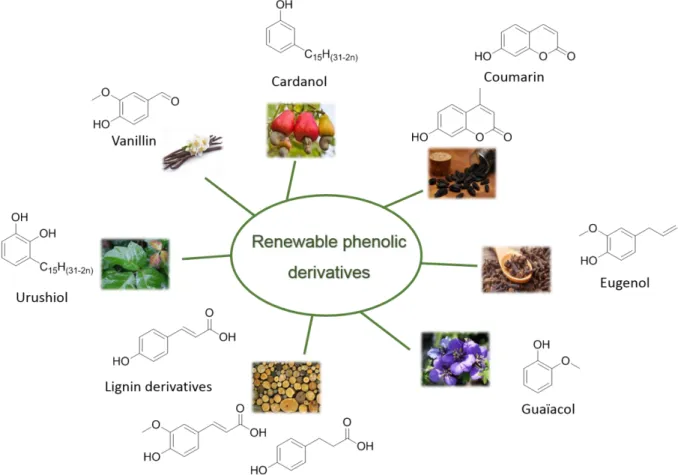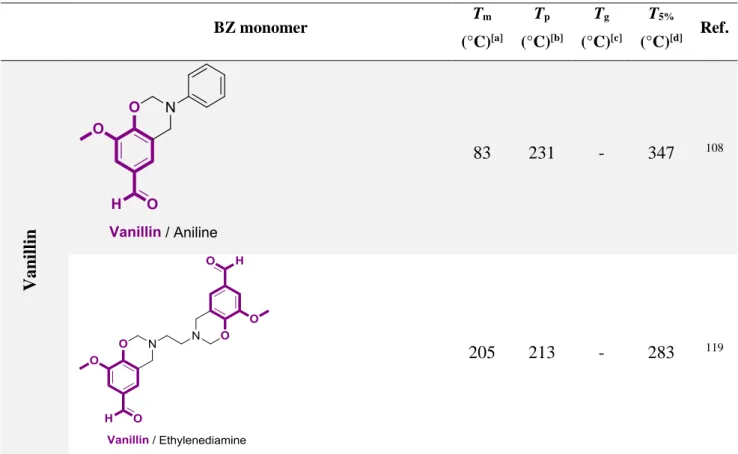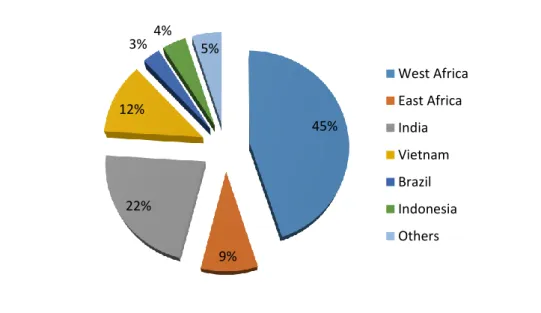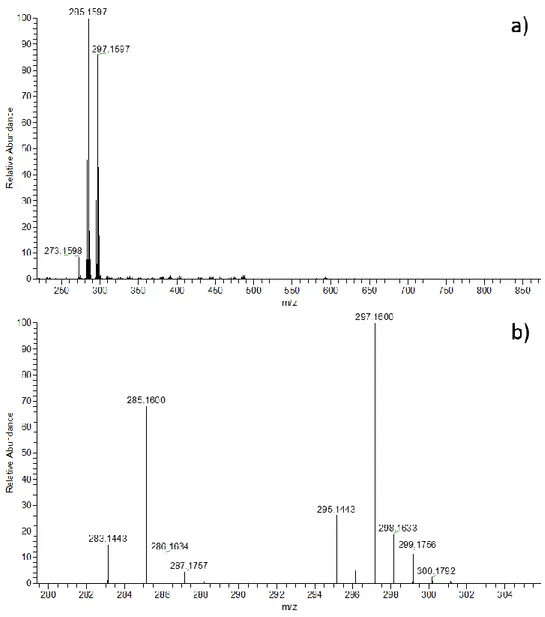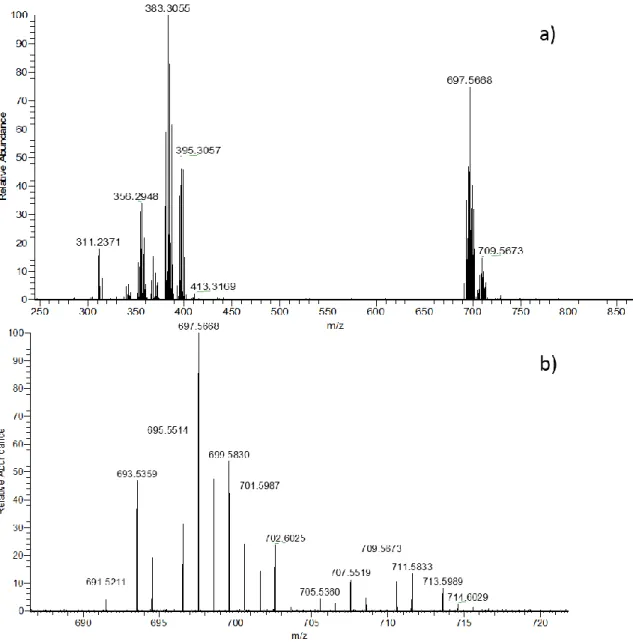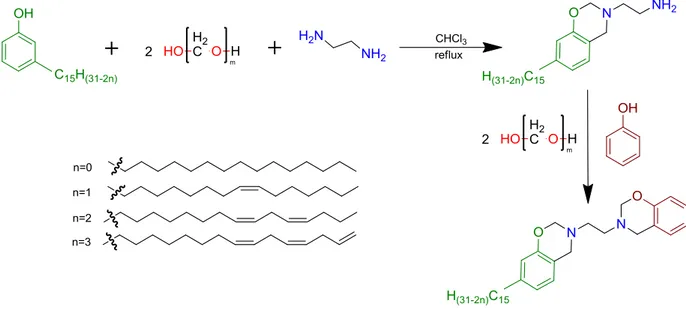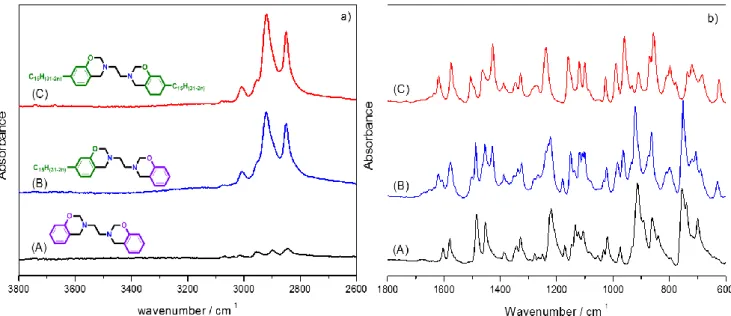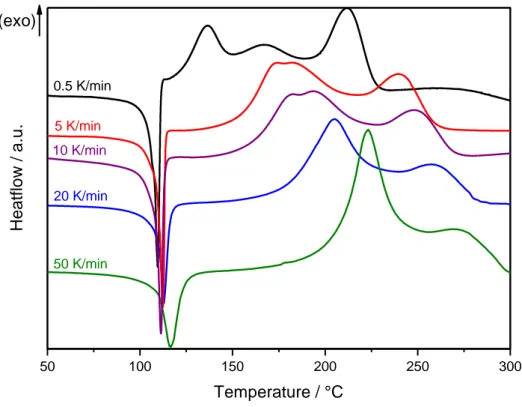HAL Id: tel-02570341
https://tel.archives-ouvertes.fr/tel-02570341
Submitted on 12 May 2020HAL is a multi-disciplinary open access archive for the deposit and dissemination of sci-entific research documents, whether they are pub-lished or not. The documents may come from teaching and research institutions in France or abroad, or from public or private research centers.
L’archive ouverte pluridisciplinaire HAL, est destinée au dépôt et à la diffusion de documents scientifiques de niveau recherche, publiés ou non, émanant des établissements d’enseignement et de recherche français ou étrangers, des laboratoires publics ou privés.
polybenzoxazines and dialdehyde cellulose based
composites
Rime Ganfoud
To cite this version:
Rime Ganfoud. Towards greener thermosets : cardanol-based polybenzoxazines and dialdehyde cel-lulose based composites. Other. Université Côte d’Azur, 2018. English. �NNT : 2018AZUR4209�. �tel-02570341�
THÈSE DE DOCTORAT
Towards greener thermosets: Cardanol-based
polybenzoxazines and dialdehyde cellulose-based
composites
Vers des thermodurcissables bio-sourcés :
Polybenzoxazines à partir de cardanol et composites à
base de dialdéhyde cellulose
Rime GANFOUD
Institut de Chimie de Nice
Présentée en vue de l’obtention du grade de docteur en Chimie de l’Université Côte d’Azur
Dirigée par : Pr Nicolas Sbirrazzuoli Co-encadrée par : Dr Nathanael Guigo Soutenue le : 10 décembre 2018
Devant le jury, composé de :
Pr Mohamed Naceur Belgacem, Grenoble-INP Pagora, France. Rapporteur
Pr Rosa Marìa Sebastiàn Pérez, UAB, Espagne. Rapporteur
Dr Laurent Heux, Directeur de recherche, CERMAV, France. Examinateur
Dr Pierre Verge, Ingénieur de recherche, LIST, Luxembourg. Examinateur
T H E S E
Pour obtenir le titre deDocteur en Sciences
de l’Université Côte d’Azur
Discipline : Chimie Présentée et soutenue par
Rime GANFOUD
Towards greener thermosets: Cardanol-based polybenzoxazines and
dialdehyde cellulose-based composites
Vers des thermodurcissables biosourcés : Polybenzoxazines à partir
de cardanol et composites à base de dialdehyde cellulose
Thèse dirigée par le Professeur Nicolas SBIRRAZZUOLI
Soutenance : 10 décembre 2018
Jury :
Rapporteurs
Mohamed Naceur Belgacem, Professeur Grenoble-INP Pagora, France
Rosa Marìa Sebastiàn Pérez, Professeur, Département de chimie, Université Autonome de Barcelone, Espagne
Examinateurs
Laurent Heux, Directeur de Recherche, CERMAV, France Pierre Verge, Ingénieur de Recherche, LIST, Luxembourg
Nathanael Guigo, Maitre de conférences, ICN, Université Côte d’Azur, France Nicolas Sbirrazzuoli, Professeur, ICN, Université Côte d’Azur, France
3 ABSTRACT:
To reduce the use of finite petroleum-based resources, interest has grown regarding the valorization of renewable resources in chemistry. The work presented in this thesis focused on two bio-based resources: plant oil and lignocellulosic biomass, for the preparation of greener thermoset materials. The first part discussed about polybenzoxazine thermosets. The bio-based content was gradually increased through substitution of petro-based phenol by bio-based cardanol. Cardanol is a natural phenolic derivative extracted from the cashew nutshell liquid. A first study focused on the effect of this aliphatic side chain and how it can tune the reactivity and the final thermo-mechanical properties of the materials. In the following study the reactivity of polymerization of di-phenol monomer was investigated using advanced isoconversional analyses and thermo-mechanical analyses for a better understanding of the polymerization reaction. The second part discussed about the preparation of fully bio-based composites using modified cellulose microfibrils (MFC). Poly(furfuryl alcohol) (PFA) is a bio-based matrix obtained after polymerization of furfruyl alcohol (FA) with maleic anhydride, both obtained from HMF. The PFA properties can be modified by the introduction of cellulose as a filler. MFC was modified by oxidation to lead to reactive dialdehyde functions. By varying the degree of oxidation (DO), the properties of different composites were studied to determine the most adequate DO for the better PFA/MFC compatibility and the most adequate PFA/MFC ratio. Finally, the last study of this thesis focused on the concept of “all cellulose composites” (ACC), and particularly how to reduce the moisture sensitivity of these materials. Two different furanic compounds were used as cross-linkers to increase the hydrophobicity: a first compound with one furan ring and a second with two furan rings.
Key words: Benzoxazine, bio-based polymers, cardanol, cellulose microfibrils, composites, dialdehyde cellulose, furfuryl alcohol, thermosets
RÉSUMÉ :
L’utilisation et la valorisation de ressources renouvelables dans le domaine de la chimie connait un intérêt grandissant pour remplacer les ressources fossiles. Le travail présenté dans ce manuscrit de thèse est axé sur deux ressources bio-sourcées utilisées pour la préparation de thermodurcissables bio-sourcés : huile végétale et biomasse lignocellulosique. La première partie concerne les polybenzoxazines. A partir d’un monomère à base de phénol, le caractère bio-sourcé est progressivement augmenté par substitution du phenol par du cardanol. Le cardanol est un dérivé phénolique bio-sourcé extrait de l’huile de coque de noix de cajou. Une première étude se concentre sur les effets apportés par cette chaine alkyle sur la réactivité et les propriétés finales du matériau. Par la suite, la réaction de polymérisation du composé de référence est évaluée par des études cinétiques, corrélées aux analyses thermo-mécaniques pour une meilleure compréhension de la réaction de polymérisation. La seconde partie de cette thèse se concentre sur la préparation de composites totalement bio-sourcés, avec des microfibrilles de cellulose (MFC) modifiées pour obtenir des dialdehyde cellulose (DAC). Le poly(alcool furfruylique) (PFA) est une matrice bio-sourcée polymérisée à partir d’alcool furfurylique (FA) et d’anhydride maléique, tous deux obtenus à partir du HMF. Les propriétés du PFA peuvent être modifiées en y incorporant un renfort, tel que la cellulose. La modification de MFC par oxydation génère des fonctions aldéhydes réactives qui améliorent la compatibilité avec la matrice. Cette étude compare différents composites préparés à partir de MFC oxydée à différents DO pour déterminer quel DO entraine une meilleure compatibilité. Pour finir, des matériaux préparés à partir d’une unique source de cellulose, les « all cellulose composites », ont fait l’objet de la dernière étude. Deux différents renforts furaniques ont été utilisés pour contrer les problèmes de sensibilité à l’humidité de la cellulose, et donc augmenter l’hydrophobicité.
Mots clés : Alcool furfurylique, benzoxazine, cardanol, composites, dialdéhyde cellulose, microfibrilles de cellulose, polymères bio-sourcés, thermodurcissables
5
Remerciements
J’adresse mes sincères remerciements au Professeur Nicolas Sbirrazzuoli, directeur de l’équipe Matériaux et Polymères Eco-Compatibles, pour son accueil au sein de son équipe afin de réaliser mes travaux de thèse, ainsi que pour son encadrement au cours de ces trois années. Je remercie aussi le Docteur Nathanael Guigo pour son aide et son suivi au cours de cette thèse.
Je souhaite également exprimer ma reconnaissance aux membres du jury de thèse, Pr. Mohamed Naceur Belgacem, Pr. Rosa Maria Sebastiàn, Dr. Laurent Heux, et Dr. Pierre Verge, d’avoir accepté d’évaluer ce travail.
Je souhaite remercier tous les membres du laboratoire de l’Institut de Chimie de Nice, passés et présents, pour l’aide et le soutien qu’ils m’ont apporté. Je remercie également, les doctorants de l’équipe, ainsi que les anciens pour leur bonne humeur et les moments agréables passés avec eux aussi bien au laboratoire qu’en dehors.
Enfin, je remercie tout particulièrement mes amis, et ma famille pour leur soutien durant ces années.
7
List of abbreviations
A Pre-exponential factor
Ac2O Acetic anhydride
ACC All Cellulose Composite
AGU Anhydroglucose Unit
ATR Attenuated Total Reflectance
BHMF 2,5-bis(hydroxymethyl)furan
BMI Bismaleimide
BZ Benzoxazine
CHCA α-cyano-4-hydroxycinnamic acid CHCl3 / CDCl3 Chloroform / deuterated
CNSL Cashew Nutshell Liquid
Cp Heat capacity J.g-1.K-1
DAC Dialdehyde cellulose
DCM Dichloromethane
DGEBA Diglycidylether of bisphenol A
DHMF 5,5′-dihydroxymethyl furoin di-BZ Di-benzoxazine monomer
DMA Dynamic Mechanical Analysis
DMSO d6 Dimethylsulfoxide deuterated
DO Degree of oxidation
DSC Differential Scanning Calorimetry
E’ / G’ Storage modulus Pa
E’’ / G ‘’ Loss modulus Pa
Eα Apparent activation energy J.mol-1
EDA Ethylenediamine
EDX Dispersive X-ray spectroscopy
Et3N Triethylamine
f(α) Mathematical function associated to the reactional mechanism
FA Furfuryl alcohol
FTIR Fourier-Transform Infrared Spectroscopy
8
Hi Partial enthalpy of reaction J.g-1
HMTA Hexamethylenetetramine
HOAc Acetic acid
HRMS High Resolution Mass Spectrometry
k(T) Rate constant S.I.
LiCl/DMAc Lithium chloride/N,N-dimehtylacetamide
MA Maleic anhydride
MALDI Matrix-Assisted Laser Desorption/Ionization
MCC Microcrystalline cellulose
mCPBA Meta-perchlorobenzoic acid
MFC Microfibrillar cellulose
mono-BZ Mono-benzoxazine monomer
MS Mass Spectrometry
NaOMe Sodium methanolate
NCC Nanocrystalline
NFC Nanofibrillar cellulose
PBZ Polybenzoxazine
PFA Poly(furfuryl alcohol)
PTFE Polytetrafluoroethylene
NMR Nuclear Magnetic Resonance spectroscopy
R Gas constant J.mol-1.K-1
ROP Ring-opening polymerization
RT Room Temperature
SEM Scanning Electron Microscopy
SOCl2 Thionyl chloride
tan δ Damping factor
TEM Transmission Electron Microscopy
TEMPO 2,2,6,6-tetramethylpiperidine-N-oxyl
TGA Thermogravimetric Analysis
TLC Thin Layer Chromatography
TOF Time-Of-Flight
TPT-OMe 5-Methoxy-1,3,4-triphenyl-4,5-dihydro-1H-1,2,4-triazoline
9 T5% 5 wt% loss temperature °C T10% 10 wt% loss temperature °C Tα Temperature of α relaxation °C Tβ Temperature of β relaxation °C Tγ Temperature of γ relaxation °C
Tg Glass transition temperature °C
Tg∞ Infinite glass transition temperature °C
Tm Melting temperature °C
Tp Polymerization temperature °C
Tr Reaction temperature °C
Tv Temperature of vitrification °C
α Extent of conversion
αi Extent of conversion at time ti
β Heating rate K.min-1
ΔHi Heat released at time ti J.g-1
ΔHtot Total heat released J.g-1
ϕ Heat flow W.g-1
11
General Introduction
15Part I – Polybenzoxazine thermosets
21
Chapter I: From petrobased to bio-based thermosets – State of the art
23I. History of thermosets engineering 25
II. General characteristics of thermosets 26
II.1. Gelation 26
II.2. Glass transition and vitrification 26
III. Main classes of thermosets 28
III.1. Phenol-Formaldehyde resins 29
III.1.1. Properties of phenolic resins 31
III.1.2. Drawbacks of phenol-formaldehyde resins 31
III.2. Epoxy resins 32
III.2.1. Polymerization process 33
III.2.2. Properties and applications of epoxy resins 34
III.3. Polybenzoxazine resins – A new generation of phenolics 35
III.3.1. Commercialization of polybenzoxazine resins 37
III.3.2. Synthesis of the monomer 41
III.3.3. Ring-opening polymerization and cure mechanism 43
III.3.4. Di-functional benzoxazine monomers 44
III.3.4.1. Synthesis and properties of diamine bridging groups 45
III.3.5. Benzoxazine monomers from renewable phenolic derivatives 48
IV. References 55
Chapter II: Cardanol-based benzoxazine resins: structure-to-properties
relationship
63I. Introduction 65
II. Materials and methods 69
II.1. Materials 69
II.2. Liquid state NMR characterization 69
II.3. Mass analysis 69
II.4. FT-IR analysis 69
II.5. Differential Scanning Calorimetry (DSC) 70
II.6. Rheological analysis 70
II.7. Dynamical Mechanical Analysis (DMA) 70
II.8. Thermogravimetric Analysis (TGA) 70
III. Results and Discussions 72
III.1. Monomers synthesis and structural characterization 72
III.1.1. Symmetric benzoxazines synthesis 72
III.1.1.1. 1H NMR characterization 73
12
III.1.1.2. Mass characterization 81
III.1.3. Purification process 82
III.1.4. FT-IR characterization of benzoxazine monomers 83
III.2. Thermo-analytical follow-up of ring opening and cross-linking reactions 84
III.2.1. Characterization by DSC 84
III.2.2. DSC vs TGA correlation 89
III.2.3. Chemorheology of polymerization 90
III.3. After cure completion, characterization and final properties of the polybenzoxazine resins 92
III.3.1. Material preparation 92
III.3.2. FT-IR characterization of the polymers 93
III.3.3. Thermo-mechanical characterization by DMA 94
III.3.4. Thermal stability of the cured products 97
IV. Conclusion 100
V. References 101
VI. Supplementary Information 107
Chapter III: Physico-chemical aspect of phenol-based benzoxazine
polymerization
109I. Introduction 111
II. Thermokinetic analysis 113
II.1. Extent of conversion and apparent activation energy 113
II.2. Isoconversional methods: Principle and Advanced kinetic methods 114
II.3. Advanced isoconversional analysis 115
III. Results and Discussions 116
III.1. Non-isothermal kinetic analysis of di-phenol benzoxazine polymerization reaction 116
III.2. Apparent activation energy 117
III.3. Thermal and thermomechanical analyses and kinetic studies 120
III.4. Chemorheological analysis and kinetic study 121
III.5. Evolution of glass transition temperature (Tg) over curing 122
IV. Isothermal analysis 124
IV.1. DSC measurements 124
IV.2. Isoconversional analysis in isothermal mode of di-phenol BZ 125
V. Conclusion 127
13
Chapter IV: From lignocellulosic biomass to bio-based thermosets – State of the
art
135I. Vegetable biomass 137
I.1. The complex architecture of plant cell wall 137
I.2. Composition of plants 138
I.2.1. Cellulose 138
I.2.1.1. Molecular structure 139
I.2.1.2. Cellulose biosynthesis 140
I.2.2. Hemicellulose 140
I.2.3. Lignin 142
I.2.4. Other compounds 143
II. From in situ cellulose to cellulosic raw materials 143
II.1. The different sources of cellulose 143
II.2. Extraction of cellulose from biomass 144
II.2.1. Mechanical pulp 144
II.2.2. Chemical pulp 144
II.2.3. Chemi-(thermo)mechanical pulp 144
II.3. The different forms of isolated cellulose 144
II.3.1. Thermo-mechanical properties 146
II.4. Surface modification of cellulose 147
II.4.1.Substitution: cellulose esterification 148
II.4.2. Substitution: cellulose etherification 148
II.4.3. Cellulose oxidation 149
III. From lignocellulosic biomass to furanic building blocks and polymers 152
III.1. Furfuryl alcohol 155
III.1.1. Synthesis of furfuryl alcohol 155
III.1.2. Properties, reactivity, and applications 156
III.1.3.From furfuryl alcohol to poly(furfuryl alcohol): polymerization mechanism 157
IV. References 161
Chapter V: Microfibrillar cellulose: a suitable filler for bio-based composites
within a poly(furfuryl alcohol) matrix
171I. Introduction 173
II. Experimental section 175
II.1. Chemical materials 175
II.2. FTIR Spectroscopy 175
II.3. Transmission Electronic Microscopy (TEM) 175
II.4. Differential Scanning Calorimetry (DSC) 175
14
II.8. Determination of the degree of oxidation (DO) 176
II.9. Material preparation 177
III. Results and Discussion 179
III.1. FTIR analysis 179
III.2. DSC measurements of FA polymerization in presence of MFC 180
III.3. Microscopic morphology characterization by TEM 182
III.4. Thermo-mechanical properties investigation by DMA 184
III.5. Thermal properties investigated by TGA 188
IV. Conclusion 189
V. References 191
VI. Supplementary Information 194
Chapter VI: Hydrophobization of thermoset-like all cellulose composites __
195 I. Introduction 197II. Experimental section 200
II.1. Characterization techniques 200
II.1.1 Liquid state NMR 200
II.1.2. FT-IR spectroscopy 200
II.1.3. Scanning electron microscopy (SEM) 200
II.1.4. Water contact angle 200
II.1.5. Dynamic mechanical analysis (DMA) 200
II.2. Chemical materials 201
II.3.Preparation of 5,5′-dihydroxymethyl furoin (DHMF) 201
II.3.1. Characterization by 1H NMR 202
II.3.2. Characterization by FT-IR 203
II.4.Processing of the all cellulose composites 204
III. Results and Discussions 206
III.1. Structural characterization 206
III.1.1. FT-IR characterization 206
III.1.2. Macroscopic and microscopic morphologies of the thermosets ACCs 208
III.2. Moisture sensitivity 211
III.3. Thermo-mechanical properties of the composites by DMA 215
IV. Conclusion 219
V. References 220
VI. Supplementary Information 222
17
In the last two decades, the chemistry of renewable resources and related bio-based materials got the attention of scientists, from both the academy and the industry. Nowadays, the petroleum dominance in Chemistry for the synthesis of synthons is almost total, including the field of polymers and advanced materials. The world production of plastic is continually increasing reaching 335 million tonnes in 2016 (against 322 in 2015 and 311 million tonnes in 2014). This production applies for a wide range of applications such as packaging (39.9 %), building and construction (19.7 %), automotive (10 %), electrical and electronics (6.2 %), and agriculture (3.3 %)1. However, the rarefaction of this resource impacts directly on the world economy as it is not renewable on a human scale, and the immoderate use of petroleum by-products leads to important environmental damages. To accommodate the needs of a growing world population with the resulting impact on our environment is one of the biggest challenges of today’s society.
Figure 1. Plastic world production in 2016. Source: PlasticsEurope Market Research Group (PEMRG) and Conversion Market & Strategy GmbH.
To regulate this man-made disruption on the environment, a common agreement has been endorsed through the Kyoto protocol in 1997 in order to reduce the greenhouses gas emissions. Ten years later, the REACH directive (Registration, Evaluation, and Authorization of Chemicals) entered into force in 2007 to increase the legislation on safety and chemical management, according to the principles of Green Chemistry. This concept has been defined in the 90’s by Paul Anastas and John Warner2. From 12 principles, they encourage “invention,
18
conception, and application of chemical products and processes that aim at reducing the utilization and production of dangerous compounds”. Thus, the scientific community started to develop for the last two decades processes for polymers from renewable resources, motivated by the 7th principle.
Crude oil, coal, natural gas, and biomass are sustainable resources of carbon. Vegetable biomass is a good candidate for sustainable raw materials for the preparation of polymers. It is estimated to 10,000 billion of tons. Research is mainly based on this resource to create new synthesis processes, both ecologic and sustainable, and lead to more eco-friendly materials. Following this idea, researchers could extract molecules used for chemical syntheses and polymers preparation essentially from agricultural waste and bio-refinery by-products. The use of natural resources from non-food crops and non-edible by-products allows a valorization of these second and third generation feedstocks, which were stocked or burnt until a few years ago, and are still mainly burnt. The re-use of these materials is part of the circular economy. In addition, when these materials are bio-based we talk about bio-economy. Among the possible raw renewable materials available from vegetable biomass, two bio-resources present a high potential to replace petroleum: plant oil and lignocellulosic biomass.
Cardanol is a natural oil extracted from the Cashew Nutshell Liquid (CNSL), and is an economical and abundant non-edible agricultural by-product used in many applications in research and industry3. More than a sustainable, available, and at an advantageous price,
cardanol presents an aromatic structure with a 15 carbons aliphatic side chain which makes it an interesting and promising natural phenol derivative.
The lignocellulosic biomass is composed, among other things, of hemicellulose. After chemical treatment and acid hydrolysis, furfuryl alcohol (FA) is extracted from the hemicellulose. The FA is a bio-based monomer that can be polymerized with an acid catalyst to form a bio-based thermoset. Moreover, the cellulose is the most abundant natural polymer present in plant biomass. It remains the most explored and exploited as it is very promising for new material applications since its physico-chemical properties offers a wide potential for innovation. Cellulose is often used as a reinforcement compound but can also be chemically modified for the preparation of new types of bio-based thermosets.
Thus, the work presented in this thesis is based on the preparation of greener thermosets and composites. The thesis is separated into two parts: the first part concerns the study of polybenzoxazine thermoset matrix. The interest for this class of polymer is growing under the polymer community. This work was performed in collaboration with the Luxembourg Institute
19
of Science and Technology. The second part is dedicated to the preparation of fully bio-based composites from the lignocellulosic biomass. This part of the work was performed in collaboration with the Centre de Recherche sur les Macromolécules Végétales in Grenoble.
After this general introduction and context of the work, Chapter I is dedicated to the bibliographic study of thermosets further centered on polybenzoxazines (PBZ) which is the first thermoset matrix studied here.
Chapter II presents the results and discussions on three systems of benzoxazine (BZ). As the
cardanol gains more interest for the preparation of bio-based materials, this study aims at increasing the understanding of the effect of cardanol on the final polymer properties, and particularly the effect brought by the aliphatic side chain. For this purpose, di-functionalized BZ monomers were synthesized. The first was obtained using two phenols, then using one phenol and one cardanol, and finally with two cardanols.
Chapter III is dedicated to the kinetic analysis of polymerization of the first synthesized
di-phenol monomer, using advanced isoconversional analysis.
Chapter IV introduces the second part with the bibliographic part of the lignocellulosic
biomass presenting the main natural polymers and the different ways to modify cellulose. Then, a description of the obtention of FA from hemicellulose is followed by its detailed polymerization into poly(furfuryl alcohol) (PFA).
Chapter V is centered on the use of modified microfibrillar cellulose as a filler to reinforce the
PFA and improve its stiffness.
Chapter VI focuses moisture sensitivity issue of cellulose, in the form of thermoset-like “all
cellulose composites” (ACC). These ACC were reinforced by furanic cross-linkers to evaluate their effect of the moisture sensitivity, and thus their hydrophobicity.
Finally, a general conclusion summarizes the results obtained in this thesis and presents some outlooks.
(1) Plastics-the Facts 2017 An Analysis of European Plastics Production, Demand and Waste Data.
(2) Anastas, P. T.; Warner, J. C. Green Chemistry: Theory and Practice; New York, 8991. (3) Paramashivappa, R.; Phani Kumar, R.; Vithayathil, P. J.; Srinivasa Rao, A. Novel
Method for Isolation of Major Phenolic Constituents from Cashew (Anacardium Occidentale L.) Nut Shell Liquid. J. Agric. Food Chem. 2001, 49 (5), 2548–2551.
Part I
From petro-based to bio-based
thermosets – State of the art
II.1. Gelation __________________________________________________________________ 26 II.2. Glass transition and vitrification _______________________________________________ 26
III. Main classes of thermosets _____________________________________________ 28
III.1. Phenol-Formaldehydes resins ________________________________________________ 29
III.1.1. Properties of phenolic resins _______________________________________________________ 31 III.1.2. Drawbacks of phenol-formaldehyde resins ____________________________________________ 31
III.2. Epoxy resins ______________________________________________________________ 32
III.2.1. Polymerization process ____________________________________________________________ 33 III.2.2. Properties and applications of epoxy resins ____________________________________________ 34
III.3. Polybenzoxazine resins – A new generation of phenolics __________________________ 35
III.3.1. Commercialization of polybenzoxazine resins __________________________________________ 36 III.3.2. Synthesis of the monomer _________________________________________________________ 39 III.3.3. Ring-opening polymerization and cure mechanism ______________________________________ 41 III.3.4. Di-functional benzoxazine monomers ________________________________________________ 42 III.3.4.1. Synthesis and properties of diamine bridging groups ________________________________ 43 III.3.5. Benzoxazine monomers from renewable phenolic derivatives _____________________________ 45
25
I.
History of thermosets engineering
“Resin or plastic compounds which in their final state as finished articles are substantially infusible and insoluble. Thermosetting resins are often liquid at some stage in their manufacture or processing, which are cured by heat, catalysis, or other chemical means. After being fully cured, thermosets cannot be resoftened by heat. Some plastics which are normally thermoplastic can be made thermosetting by means of cross-linking with other materials.” This
is the definition of thermosets found in Whittington’s Dictionary of Plastics1.
A large variety of thermoset polymers has been developed during the years, essentially because of the economical commercialization of key precursor materials rather than a result of a chemist’s ability to adjust polymers for specific characteristics and properties. The notion of macromolecules of Staudinger2 is relatively recent as it was proposed and accepted only in the late 1920’s. The concept of macromolecules was then in contrast with the micellar theory that describes big molecules as an aggregation of smaller molecules, kept together by non-covalent interactions.
Polymers can be classified considering various criteria (e.g. origin, structure, stereochemistry, number of monomers, connectivity, properties, applications, etc.). Within this classification can be found rubbers. Rubbers, naturals or synthetics, are widely used industrial products. It presents the main properties to be tough, elastic, water and chemical resistant, hard to tear, and resist to abrasions and impacts. These properties lead to their use in tires or gloves. The subcategory “Plastics” of the polymers can be differentiated into two main categories, thermoplastics and thermosets, depending on their response to temperature3. Thermoplastics are constituted of linear or branched polymer chains which are known to be re-moldable and recyclable. Thermosets are covalent cross-linked polymer forming a three-dimensional network. Due to this strong architecture, a thermoset is considered infusible, insoluble, and non-recyclable (they are sometimes re-used by grinding them to make composites). On the other hand, they possess very high thermo-mechanical properties. However, recent research focused on the recyclability of thermosets4,5, particularly for a better environmental impact.
26
II.
General characteristics of thermosets
II.1. Gelation
Thermosets are very interesting materials and widely used in the industry. For a better understanding of the material, it is important to understand their general characteristics. Among them, the gelation phenomenon is a transition occurring during curing where the molecular weight reaches nearly the maximum and is usually assumed to be infinite. At this point, all monomers are connected by at least one covalent bond, forming an insoluble macromolecule. Gelation is a microscopic transformation producing macroscopic changes. This phenomenon depends on the chemistry of the system and occurs at a specific degree of conversion6. The microscopic gelation itself is difficult to measure as the obtained network is insoluble with a molecular weight close to infinite. In contrast, the macroscopic effect is easier to detect. The macroscopic gel point can be identified by thermo-mechanical techniques such as rheological analysis or dynamic mechanical analysis (DMA). Above gelation, there is no more increase in the molecular weight, but the cross-link density increases and the free chain segment length decreases7. Gelation is important from an industrial processing point of view because when the
viscosity is high, it affects the general processability of thermosets and composite prepregs. And depending at which stage of curing the gelation occur, it affects the final properties of the material such as the stiffness and adhesion. In general, thermosets cannot be processed above gelation. Gillham8 suggested to determine the gelation point as the peak in the tangent delta from a frequency depended isothermal DMA measurement. DMA transitions show frequency dependence; however, the gel point is defined as the point where the tangent delta becomes frequency independent. A common method is to use the crossover point between the storage and the loss moduli, and it can also be defined in term of viscosity as it is correlated with the maximum of viscosity9. The method proposed by Gilham is known to be the most reliable, even though it is more time consuming than other methods.
II.2. Glass transition and vitrification
The glass transition temperature (Tg) is an important characteristic of polymeric materials. This
temperature correlates to a drastic variation of the heat capacity (Cp) and therefore, to the
material’s mechanical properties. Thus, it can be measured either by Differential Scanning Calorimetry (DSC) or by Dynamic Mechanical Analysis (DMA). Note that the transition measured by DMA is not strictly identical to the glass transition measured by DSC. DMA measure the α-relaxation (Tα) which corresponds to a mechanical relaxation, while DSC
27
measures the heat capacity variation that is associated to the transition from the glassy state to the rubbery state (Tg) or from the rubbery state to the glassy state (i.e. vitrification, Tv). The
glass transition temperature is defined as a temperature domain of the transition from the glassy state to the viscoelastic or rubbery state during thermal treatment. The understanding of this critical feature is important for applications, because it determines the mechanical properties of the material at a given temperature. During the cross-linking, vitrification can occur if the Tg is
equal or becomes higher than the reaction temperature (Tr). This phenomenon of vitrification
corresponds to the transition from the liquid to the glassy state and induces a high decrease of the molecular motion. It can occur before or after gelation and can be observed for isothermal or non-isothermal curing processes. Vitrification is also important in term of processability as the kinetic of polymerization is highly decreased in the glassy state. It was shown that at this stage, the reaction is not chemically controlled but controlled by diffusion10. This effect becomes relevant with an increase of the difference between the glass transition temperature and the reaction temperature (Tg – Tr). When this difference reaches 20 – 40 °C11, the reaction
is considered as stopped. During the polymerization, the Tg value increases with conversion as
the molar mass increases in the pre-gel state as well as the cross-link density in the post-gel state.
To summarize the concepts presented above, the Time-Temperature-Transformation (TTT) diagram developed by Gillham for thermosetting systems8 shows the transitions between the
different states and phenomena taking place during the cross-linking (Figure 1). The TTT diagram presents the three critical temperatures of the glass transition noted Tg0, Tg gel, and Tg∞
which correspond to the glass transition temperature of precursors before any reaction, the temperature of coincidence between gelation and vitrification, and the glass transition temperature of the fully cross-linked system, respectively.
28
Figure 1. Time-Temperature-Transforamtion (TTT) diagram by Gillham8.
III.
Main classes of thermosets
The first successful commercial venture based on polymers started when Charles Goodyear discovered the process of vulcanization of natural rubber in 183912. Plastics industry started with the world’s first synthetic plastic, Bakelite, developed by Leo Baekeland in 190913.
Bakelite was dominant in the plastics technology for many years commonly used in the coating industry for protective purposes and in electrical and automobile industry for its low conductivity properties and high heat resistance. Nowadays, the advance of various milestones in thermosetting resin technology (Table 1) allows to progressively substitute Bakelite, either being easier to manufacture or at a lower cost. The main industrially used thermoset resins are described in the following sub-chapters.
29 Table 1. Historical milestones of thermosets9.
1839 Vulcanization of rubber by Goodyear
1909 ‘Heat and Pressure’ patent for phenolic resins by Baekeland 1928 Commercial introduction of Urea-formaldehyde
1933 Patent on unsaturated polyester resins by Ellis
1937 1st production of polyurethanes
1939 1st patent on epoxy
1942 Industrialization of silicon by Dow Corning
1947 Commercialization of epoxy
1954 Polyurethanes introduced in the US
1964 Polyimides introduced as a fabricated product
1970s 1st patent on cyanate esters by Mobay & Bayer
1970s Polyimides thermosets expand into high-T adhesives and composites for aerospace applications
1980–1990s Development of BMI & BMI copolymer commercial applications
III.1. Phenol-Formaldehydes resins
First developed in the beginning of the 20th century, resins based on the use of formaldehyde and obtained by polycondensation have found interest in many fields, like insulation, coatings, electrical devices, automotive parts, or adhesives and mainly in wood industry14. Phenol-formaldehyde resins are the first fully synthetic man-made resin, from the polycondensation reaction between phenol and formaldehyde (Scheme 1).
Scheme 1. Chemical reaction leading to phenol/formaldehyde resin.
The use of phenolic resins was promoted by the “heat and pressure” patent of Leo Baekeland in 1909. The patent involved the use of high pressure and closed mold, to avoid the problems of bubbles and the evolution of gases and steam. Fillers were used to avoid the problem of brittleness of polymerized phenolic resin by enhancing its properties13,15,16. Depending on the
30
phenol/formaldehyde ratio and the used catalyst, these phenolic resins are differentiated in two types: resol phenolic resins and novolac phenolic resins9,17,18.
Resol phenolic resins
Resol phenolic resins are produced by the polymerization of phenol and formaldehyde solution, with an alkaline catalyst, at 100 °C for about 1 hour. The most usual conditions include 1.1 to 1.5 mole of formaldehyde for 1 mole of phenol. At this stage of polymerization, the product is an intermediate gel-like resin. To have a solid product, the intermediate is dried under vacuum for 3 to 4 hours. Under these conditions, resol phenolic resins belong to water-soluble thermoplastics. To reach the final thermoset material, heating above its gel point initiates the curing process. Resol resins have reactive methylol and hydroxyl groups which participate to the formation of larger molecules through methylene cross-linking reactions, without addition of a curing agent.
Resol phenolic resins have a short shelf life (less than 1 year) and have the advantage to not require curing agent but only heat to initiate the cross-linking reactions. However, its cross-linking occurs through a polycondensation reaction, leading to water as by-product.
Novolac phenolic resins
In contrast to the resol phenolic resins, the polymerization for novolac phenolic resins requires the presence of an acid catalyst and present an infinite shelf life under usual storage conditions and require a hardener for the cross-linking. Usually, a pre-polymerization step is performed with a phenol-formaldehyde ratio of 1:0.8. After a polymerization of 2 to 4 hours at 160 °C for water removal, a low molecular weight molten intermediate is obtained. The corresponding glassy material is obtained after cooling and blended with powdered hexamethylene tetramine (HMTA). Upon heating, the HMTA provides the formaldehyde necessary for the final curing, giving to the resin a final phenol-formaldehyde ratio of 1:1.5.
Some differences between resol type and novolac type phenolic resins are listed in Table 2 below.
31
Table 2. Main differences between resol and novolac phenolic resins.
Resol phenolic resins Novolac phenolic resins
Alkaline catalyst Acidic catalyst
Quench Pre-polymerization
Methylol bearing resins Non methylol bearing resins
Short shelf life Infinite shelf life
By-product: water By-product: ammonia
Liquid Solid
III.1.1. Properties of phenolic resins
Phenolic resins are available in the forms of flaks, films, liquid, and powder. They are considered to be general-purpose thermosets and cost about 1.85 € per kilogram19–21. Classical phenolic resins based on resol and novolac reach an annual worldwide production volume of approximately 4.7 million tons in 201422. These resins offer attractive characteristics such as high mechanical strength, heat resistance and dimensional stability, high resistance against various solvents, acids and water. They are flame resistant materials and induce low smoke upon incineration. Their composites, through their good heat and flame resistance and low cost, find a major place in thermo-structural application in the aerospace industry14,23. Moreover,
phenolic resins can be easily molded into different shapes and present low volume shrinkage. Novolac-based resins are more dimensionally stable as they release ammonia upon curing, compared to resol-based resins which release water, as water molecules are larger than ammonia molecules, which can create more, or larger defects within the material9.
III.1.2. Drawbacks of phenol-formaldehyde resins
Phenolic resins present some major shortcomings. They cure at a relatively high temperature by a polycondensation reaction which releases by-products. This requires the application of pressure during molding and curing to avoid the formation of bubbles and form a void-free component. The curing reaction requires the use of a catalyst. The final resol type resins present a limited shelf-life at ambient conditions, while novolac type resins release ammonia during the process. Moreover, as for many neat matrices, phenolic resins are very brittle, due to their rigid aromatic units held by short methylene linkages.
To try to overcome these drawbacks, different strategies have been studied, e.g. either by incorporation of fillers24–28 or by modifying the chemistry with the concept of addition cure
32
phenolics29–31. In this concept, a new chemistry is needed to modify the cure, particularly the
cross-linking without the production of volatiles.
III.2. Epoxy resins
In 1943, Pierre Castan patented his process for the preparation of an artificial thermosetting resin32. The first commercially available and until today, the most popular epoxy resin, is
synthesized from the reaction of bisphenol A with epichlorohydrin, resulting in diglycidyl ether of bisphenol A (DGEBA). This chemical reaction is described in Scheme 2. Epichlorohydrin is generally used in large excess or can also be used as solvent. Sodium hydroxide is added either in aqueous or alcoholic solution to form a phenolate intermediate33. In general, the mechanism is described as two competitive reactions between a phenolate ion (Ar–O-) and epichlorohydrin. The first reaction is a one-step reaction of nucleophilic substitution with the cleavage of C–Cl bond; the second reaction is a two-step reaction associated with a ring-opening of the epichlorohydrin by the phenolate ion followed by an intra-molecular cyclization of the generated alcoholate which goes with a release of chlorate anion.
Scheme 2. Chemical reaction between bisphenol A and epichlorohydrin to form DGEBA monomeric
resin. With n = number of repeating units, from 0 to 25 for typical commercial product.
This epoxidation strategy has the advantage of the possibility of tailoring the length and molecular weight of the pre-polymer. Thus, DGEBA characteristics depend mainly on the molar ratio epichlorohydrin/bisphenol A. Other strategies of epoxidation exist:
Oxidation of double bonds: epoxidation is obtained by peroxidation of C=C double bonds. The use of hydrogen peroxide (H2O2) can be sufficient to generate oxiran rings.
However, if an electron withdrawing group is present in β-position of the double bond, its oxidation will require a stronger oxidative agent (such as m-chloroperbenzoic acid
33
(mCPBA)). This strategy induces a complex purification process of the epoxy monomer, limiting its industrial development34,35.
Via glycidyl (meth)acrylate: the epoxidation is obtained through the reaction of a glycidyl (meth)acrylate with another co-monomer containing a vinyl or (meth)acrylic group by free radical polymerization36.
III.2.1. Polymerization process
DGEBA has a linear structure with a monomeric structure described in Scheme 2, and the cross-linking requires a curing agent, or hardener which can be either in liquid or solid state. An important feature of the curing process is that no volatile compounds are generated. This allows the formation of a void-free structure without application of pressure during forming or molding processing. Different pathways are possible to generate macromolecular networks of epoxy thermosets.
The step growth, or polyaddition pathway concerns the reaction of epoxy groups with a hardener (amine, alcohol, carboxylic acid…) to obtain the cross-linked 3D network. Amines are the most used curing agent for epoxies. The reaction consists of the oxiran ring opening by the primary amine nucleophilic attack leading to a hydroxyl group and a secondary amine which reacts with another oxiran ring. As shown by different authors37–39 the generation of hydroxyl
function induces a catalytic effect on the epoxy-amine reaction. A side reaction of etherification can occur in excess of oxiran groups (Scheme 3).
34
The chain-growth polymerization process includes homopolymerization and copolymerization. The homopolymerization is a self-reaction of epoxy groups that can also be induced by thermal or catalytic inductions of either nucleophilic or electrophilic species. The catalytic curing agent forms an active alkoxide which provokes the propagation. Such catalyzed chain propagations lead to relatively low molecular mass values due to several chain transfer and complex termination steps40. Copolymerization of epoxies can occur with amines, cyclic anhydride or carboxylic acid catalyzed by Lewis bases. Previous authors pointed out a strictly alternant mechanism called “living anionic copolymerization” in analogy with biological system. This kind of polymerization is supposed to avoid all chain transfer and termination reactions41,42.
III.2.2. Properties and applications of epoxy resins
Epoxies have high performance bondingability, high mechanical strength, excellent dielectric properties, low curing shrinkage because of their high density, good chemical corrosion resistance and do not release volatiles upon curing. Epoxy resins can be cured at ambient temperature or at higher temperatures or even by exposition to UV light. Usually, epoxies cured under heat are more thermally and chemically resistant than those cured at room temperature43. The properties can be modulated depending on the desired application, by modifying the components of the resin and/or the hardener. Thus, the final resin can be flexible or rigid, can possess a high or low modulus, can be filled or foamed, or can be conductive or insulative. These resins are used in a wide range of applications including adhesives44, in electronics for encapsulation, potting and printed circuit boards45, and in aerospace industries as matrices for composites with high performances46. Epoxy resins are also widely used as floor coating. Flooring compositions were regularly developed, giving a hard, chemical resistant, smooth, and firmly adherent floor covering resin. What can be considered as a drawback for these resins is the requirement of a curing agent. Moreover, the resin and the hardener must be mixed right before utilization. The relatively high cost of epoxy resins systems (22.79 € to 89.01 € per square meter) restricts its use mainly for repairing or surfacing existing flooring substrates (e.g. concrete)47. When used as coating, the rigidity of cured epoxies can be an important
shortcoming, which can be counterbalanced by the use of a more appropriate and flexible curing agent and by controlling the stoichiometry between the resin and the hardener. Some specific properties can also be enhanced by addition of a resinous modifier (e.g. polyvinyl acetate, polystyrene…), then, the enhanced property is a characteristic property of the added resin, which has eventually a lower cost than the epoxy resin.
35
III.3. Polybenzoxazine resins – A new generation of phenolics
As previously mentioned, phenolic resins, in the family of high performance polymers, can find a wide range of applications such as aerospace and structural fields. Although classical phenolic resins cannot be substitutes for epoxy resins in many engineering areas, their composites still find a major market for thermo-structural applications essentially in the aerospace industry as they show good heat and flame resistance and low cost. However, as the polymerization occurs by a polycondensation process, small molecules are released causing void formation during the curing process which is the major drawback of this type of thermosets. In this context, a relatively new class of thermoset from the family of phenolic resins, polybenzoxazines, was developed to combine the thermal properties and flame retardance of phenolics and the mechanical performance and molecular design flexibility of epoxy systems48. Polybenzoxazine (PBZ) resins succeeded to overcome several shortcomings of conventional novolac and resol-type phenolic resins, while retaining their beneficial properties. PBZ resins can be expected to replace traditional phenolic resins or epoxy resins. The opportunity of molecular design flexibility allows a control of the properties of the cured material for specific requirement. PBZ resins present some unique features49,50:
- No catalyst or hardener required for curing - No void formation
- Near zero volumetric change upon curing - Low flammability
- Low water absorption
- Low coefficient of thermal expansion - High char yield
- High UV and chemical stability
- Excellent static and dynamic mechanical properties - Tg much higher than cure temperature
- Fast mechanical property build-up as a function of degree of polymerization.
The physical and mechanical properties of PBZ are shown to compare favorably with those of conventional phenolic and epoxy resins. The Table 3 compares the properties between those three matrices.
36
Table 3. Comparative properties of high performance polymers23.
Property Epoxies Phenolics PBZ
Cure temperature (°C) RT – 180 150 – 190 160 – 220
Max use temperature (°C) 180 200 130 – 280
Cure shrinkage (%) >3 0.002 ~0
Tensile strength (MPa) 90 – 120 24 – 45 100 – 125
Tensile modulus (GPa) 3.1 – 3.8 3.0 – 5.0 3.8 – 4.5 Tg (°C) 150 – 220 170 170 – 340
Elongation at break (%) 3.0 – 4.3 0.3 2.3 – 2.9
TGA onset (°C) 260 – 340 300 – 360 380 – 400
Dielectric constant (1 MHz) 3.8 – 4.5 4.0 – 10 3.0 – 3.5
PBZ resins show the highest tensile properties, the highest onset of thermal degradation, and a
Tg which can be raised to as much as 340 °C with proper choice of the phenolic precursor. A
remarkable feature of cross-linked PBZ resins is their strong hydrogen bonding network, as strong intra-molecular H-bonds between phenolic –OH and Mannich bridge may be responsible of the high onset temperature of thermal degradation23. Due to their outstanding properties, PBZ resins can be appropriate substitutes for epoxies. However, PBZ resin shows its own shortcomings like high curing temperature which can be in a window range of 160 – 220 °C. The brittleness of this matrix is also a major concern. Thus, modifications are required to both improve the ductility of the final polymer and reduce the polymerization temperature for expanding its applications. Different strategies were employed to try to achieve desirable properties, such as addition of polymerizable groups, co-polymerization, blends, and composites51–53.
III.3.1. Commercialization of polybenzoxazine resins
Since World War II, only a few polymers reached the commercial stage. The unique characteristics of PBZ presented above (like low dielectric constant, good adhesive properties, high flame and chemical resistance) make them highly attractive for various applications including electronic packaging or aerospace. Subsequently, some companies started to commercialize the resins and their composites. Indeed, polybenzoxazines successfully provide composite materials with outstanding characteristics both in particulate-filled54–56, and fiber-reinforced polybenzoxazine composites57–60. Many studies reported their applications in different fields such as conductive polymeric systems61,62, polymer electrolyte membrane63,64,
37
coatings65,66, electronic packaging67, aerospace composites68, and wear-resistant composites69.
Today, different di-functional PBZs are commercialized by Huntsman Advanced Materials, Gurit, Henkel Corporation, and Shikoki Chemical Corporation.
Five main types of benzoxazines are commercialized, based on bisphenol A, bisphenol F, thiobiphenol, phenolphthalein, and dicyclopentadiene, listed in Table 4. These di-functional monomers are essentially class A benzoxazines (BZ) (see next section), synthesized with aniline as primary amine.
Table 4. Main commercialized benzoxazine monomers.
Benzoxazine monomer structure Diphenol starting reagent Abbreviation Reference Bisphenol A BPA-a 70 Bisphenol F BF-a 71 Thiobiphenol TD-a 72 Phenolphtalein Boz-BP 73 Dicyclopentadiene DCP-a 74
Bisphenol A is the most explored and used due to its various properties and ease of synthesis. Bisphenol A, bisphenol F, and thiobiphenol-based benzoxazines can be synthesized in a solventless media75. From an industrially point of view, a solventless synthesis is highly
38
convenient, cost competitive, and environmentally friendly. Bisphenol A-based resins possess a low melt viscosity before cure, which is a useful property as it can easily wet the filler in processing composites59. This low melt viscosity helps the mixing with another resin, which makes it a good candidate for copolymers or alloys58,76,77. Thermal properties are important for industrial applications. For instance, in addition to thermal stability, the char yield may be important. The higher the char yield, the greater the fire-resistance behavior of the resin. Thus, among the commercialized BZ listed previously, thiobiphenol-based BZ presents outstanding properties with its high thermal stability72. The derivative of the thermal degradation profile (measured by TGA) presents a sharp peak around 300 °C followed by a broad shoulder around 350 °C with a significantly lower degradation rate with respect to bisphenol A-based resins. Morevoer, thiobiphenol-based resins present the higher char yield of 57 % (Table 5), leading to a better fire-resistant material. Phenolphthalein and dicyclopentadiene-based BZ are synthesized in solvent media73,74. Phenolphthalein-based resins show excellent thermal and thermo-mechanical properties with a high char yield of 51 %, and a high glass transition temperature (Tg) of 225 °C. Phenolphthalein is a phenolic derivative but also a color indicator
depending onthe pH. Cao et al.78 found that the phenolphthalein-based BZ resins keep its color
indicating property at a slightly higher pH than phenolphthalein (pH ~ 10 for the resin against pH ~ 8.2 for phenolphthalein). Dicyclopentadiene offers low costs and high reactivity, but its main interest is its good moisture resistance and high reduction of the dielectric constant. These properties are due to the high hydrophobicity induced by linking each phenolic part with a non-polar bridging group, leading to a hydrophobic cycloaliphatic structure. Shieh et al.74 also studied the moisture absorption of the corresponding cured resin. Among the others, dicyclopentadiene-based resin presents the lowest moisture absorption which is an outstanding characteristic for commercial applications. The moisture uptakes can act as a plasticizer, reducing the mechanical and thermal properties of the cured resin. Moreover, the dielectric constant appeared to be much lower than that of bisphenol A-based resin or traditional phenolic resin, due to a greater free volume and hydrophobicity. Such characteristics perfectly fit for applications as integrated circuit packaging material, as the absorbed moisture may ionize ionic impurities and corrode electric circuit.
39
Table 5. Thermal characteristics of commercialized benzoxazine resins.
BZ system Tg (°C) [a] T5% (°C) [b] Char yield (%) Ref.
BPA-a 173 325 29 70
BF-a 173 306 46 71
TD-a 216 342 57 72,79
Boz-BP 225 305 51 73
DCP-a 183 391 30.5 74,80
[a] Glass transition temperature; [b] Temperature at 5 % of mass loss.
III.3.2. Synthesis of the monomer
Different methods were used to synthesize benzoxazine (BZ) monomers (3,4-dihydro-2H-1,3-benzoxazine). Typical methods that were reported consist in dehydration of N-(2-hydroxybenzyl)-3-aminopropanoic acid in the presence of sulfuric acid81, condensation between aldehyde and o-hydroxy benzylamine82, reaction of primary amines with 1-(bromoethyl)-2-(chloromethoxy) benzene83, and Mannich condensation of phenol and a primary amine with formaldehyde84,85. Among these different methods, the Mannich condensation was the first to be reported and is still considered as the best pathway for BZ monomer synthesis. This method was popularized by Ishida et al. and widely used for the synthesis of various monomers49,70,86. Three precursors are required for the synthesis of BZ monomers: a phenolic derivative which is an active hydrogen containing compound, a primary amine, and formaldehyde. The synthesis described in Scheme 4 occurs in two steps. In the first step, a Mannich-like reaction leads to the formation of an iminium ion. The second step is an electrophilic aromatic substitution followed by a ring-closure, leading to the final BZ monomer.
40
Scheme 4. Classical approach for the synthesis of mono-functional BZ.
Benzoxazines can be synthesized either as mono-functional or di-functional. Di-BZ can be divided into two main groups depending on whether a di-phenol (class A) or a diamine (class B) is used as the bridging group, increasing the molecular design flexibility. The different types of monomers are pictured in Figure 2.
41
Figure 2. Chemical structures of a) mono-BZ, b) class A di-BZ, and c) class B di-BZ.
The synthesis can be performed with or without solvent. In a solventless method, the mixture of these products is heated to about 100 °C to produce BZ monomer but also ring-opened oligomers. The oligomers’ concentration is particularly increased when the reaction is performed in the molten state using aliphatic diamine. The use of a solvent minimizes the formation of oligomers87. Chloroform is usually preferred as its temperature of reflux is relatively low, which also limits the formation of oligomers. After the synthesis, BZ monomer is purified by removing the ring-opened structures using soft base washes. However, the purification step may not always be performed, depending on the following study or application, as the ring-opened oligomers may present an advantage. Indeed, the phenolic function of these ring-opened structures can catalyze the ring-opening and further polymerization to occur at lower temperatures. Cross-linking is obtained for di-functional BZ monomers70,88, while mono-functional monomers lead to linear polymers89.
III.3.3. Ring-opening polymerization and cure mechanism
The polymerization reaction of BZ is not well defined and different mechanisms have been proposed in the literature. McDonagh and Smith proposed in 1968 a mechanism describing a ring-opening through the formation of iminium ion along the chain. The mechanism presented in Scheme 5 proposes a proton migration from the oxygen to nitrogen followed by tautomerism90. In 1985, Riess et al. suggested a mechanism in which polymerization is triggered by condensation of amines with iminium ion89. Finally, later in 1999, Dunkers and
Ishida proposed a mechanism where the first step in the ring-opening of BZ is the protonation of the oxygen atom to form an iminium ion and in the second step, the polymerization occurs by a reaction of electrophilic aromatic substitution91. This mechanism proposed by Dunkers
42
heteroatoms of the oxazine ring that may be in favor of a cationic mechanism for the ring opening polymerization of BZ monomers. However, the most common method for the curing of BZ monomer into cross-linked structure is thermal polymerization, without catalyst. The mechanism can be imagined as follow: breaking of the –O–CH2 bond, tautomerism, and
electrophilic aromatic substitution92. As the polymerization produces more phenolic groups, its acidity enhances the polymerization rate and creates an autocatalytic process. Thus, the reaction of polymerization of benzoxazines is essentially regioselective. The thermal curing generates a structure via the attack of iminium ions in ortho position of the phenolic moiety. The proposed polymerization mechanism is described in Scheme 5b).
Scheme 5. a) Proposed mechanism for the initiation of curing of benzoxazines91; b) Polymerization
mechanism via ortho attack of iminium cation upon thermal activation.
III.3.4. Di-functional benzoxazine monomers
As previously mentioned, di-BZ are divided into two classes depending on the bridging group. Class A di-BZ are prepared from a di-phenol while class B are prepared from a diamine. Class B monomers bring more interest due to their large variety of phenolic derivatives and diamine reagents available, leading to a more interesting versatile synthesis. The general properties are
43
similar for class A and class B di-BZ. The rigidity or the electronic state of the bridging group presents a similar impact. However, for class B di-BZ, the nature of the diamine bridging group has a strong influence on the synthesis conditions and the thermal properties of both monomer and its corresponding polymer93–98. Moreover, the nature of the substituents of the phenolic has also an important role on the monomer functionality such as the thermal activation of the ring-opening or the cross-link density of the polymerized resin99–101.
III.3.4.1. Synthesis and properties of diamine bridging groups
Each reagent has an influence on the synthesis conditions and properties of cross-linked materials. Regarding the diamine bridging group, it can present an electron donating or withdrawing effect102. Electron donating groups such as alkyl chains can boost the formation of the oxazine ring, while electron withdrawing groups such as –CO or –SO2 may reduce the
ability to close the ring. This is explained by the ability of these groups to stabilize the mesomeric form of the phenolic groups. The basicity of the primary amine impacts its reactivity and thus the BZ synthesis87. To promote the oxazine ring closure, the basicity of the primary amine should be increased. Thus, diamine bridging groups with electron donating effect are more suitable. Among electron donating groups, aliphatic diamines are often used. The presence of an alkyl chain may bring flexibility, which may impact the conditions of synthesis. The effect of the diamine aliphatic chain length on the reaction time and thermal properties was investigated by Allen et al.103. As the aliphatic chain length increases, from short and relatively rigid to long and relatively flexible, the reaction time increases as described in Table 6.
44
Table 6. Main properties for linear aliphatic diamino-based series of BZ and their corresponding
PBZ103. Monomer Reaction time (h) Tm (°C)[a] Tg (°C)[b] G’RT (GPa)[c] T1% (°C)[d] 1.5 112 184 2.08 254 4 94 160 1.53 257 8 83 169 1.32 266 10 73 151 1.11 271 12 49 118 0.87 272
[a] Melting temperature; [b] Glass transition temperature; [c] Storage modulus at room
temperature; [d] Temperature at 1 % of mass loss.
The diamine chain length has an important influence on the reaction time of the monomer synthesis. As mentioned in the previous table, short chain length allows a faster and easier monomer synthesis. Furthermore, the length of the diamine chain can modify the thermal properties. Indeed, the melting temperature of the monomer decreases as the chain length increases, from 112 °C for a C2 chain to 49 °C for a C12 chain. When the melting temperature
decreases, the temperature range between melting and polymerization increases, leading to a larger processing window. Brittleness is a strong drawback of PBZ resins. By introducing a flexible chain, the final properties of the cross-linked polymer can be modulated. The storage modulus at room temperature (glassy state) is strongly impacted by the diamine chain length

